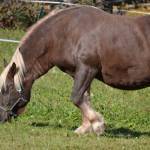Watching Broodmare Weight in Late Pregnancy

What’s wrong with letting a broodmare gain a little extra weight during the last few months of gestation? After all, she is eating for two, and we know that most of a foal’s growth occurs in the final trimester. She must need some extra padding to stay healthy, right? Most assuredly, wrong!
“We already know there seems to be a trend for larger foals, potentially due to mare obesity. Overweight mares producing heftier foals may have an increased risk of dystocia, which threatens the lives of both the mare and foal,” said Kathleen Crandell, Ph.D., a nutritionist for Kentucky Equine Research. “Overweight mares in late gestation may also have difficulty conceiving after foaling.”
In addition, Texas A&M veterinary researchers reported that foals from mares with excess condition (i.e., a body condition score of 7 or more on the Henneke 9-point scale) may be predisposed to developing metabolic diseases later in life.
This theory was explored further using 16 Quarter Horse mares maintained on pasture at a body condition score of 6 until day 235 of gestation. Mares were then moved to drylots and maintained on free-choice coastal Bermudagrass hay. Mares in the treatment group were offered an additional 40% of their dietary requirements to gain excess condition late in gestation. After analyzing samples from various skeletal muscle groups in the foals immediately after birth, the researchers found:
- Changes in certain proteins found in specific skeletal muscles that play important roles in the insulin receptor signaling cascade. These changes may contribute to the development of metabolic abnormalities in the foal’s future;
- A higher ratio of type I (slow-twitch) to type II (fast-twitch) muscle fibers in foals from overweight mares; and
- Both type I and type II skeletal muscle fibers were larger in foals from overconditioned mares compared to the control group maintained at a body condition score of 6. These latter results demonstrated that muscle fiber development was altered in foals from overweight mares.
“Further research regarding the effect of excess condition during the last stages of a foal’s development are ongoing. Regardless, the data already available to us show alterations in development of foals born to overweight broodmares,” summarized Crandell.
Obstacles surrounding weight management include the fact that some owners are unfamiliar with body condition scoring and are drawn to the physical appearance of a rounder mare. Finally, the available charts to facilitate body condition scoring may be challenging to interpret, particularly in heavily pregnant mares.
“Look for fat deposition along the topline and the tailhead, and particularly a thickening of the crest area of the neck. With late-pregnant mares, there is no point in looking at the abdomen since the fetus will be the reason for enlargement there,” Crandell advised.
For additional information on how to best feed your broodmare, contact a Kentucky Equine Research nutrition advisor.
*Bradbery, A., J. Coverdale, C. Hammer, et al. 2018. Effect of maternal overnutrition on insulin signaling in foal skeletal muscle. Journal of Animal Science. 96(3):247–248.
**Bradbery, A.N., J.A. Coverdale, T.A. Wickersham, et al. 2019. Effect of maternal overnutrition on foal skeletal muscle fiber development. Journal of Equine Veterinary Science. 76:40.








